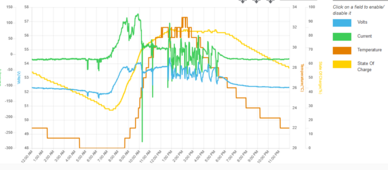CMDRZOD
New Member
Hi there. Just wondering if anyone else has noticed this.
I'm running off grid, and using extra energy to run "loads of opportunity" when PV production is good.
My system:
4x Conext MPPT 100 600 (24kw charging, overpanneled at 32kw)
3x 6848 Pro Inverters (20.4kw sustained output)
6x AES Discover Rackmount (30.5kwh)
My system prioritzies battery charging, however I curtail charging to 0.2C (~120 Amps). (I do this to extend battery life) As battery temperature rises, I lower this charge rate until we hit 30C, at 10A.
As more charging is curtailed, loads of opportunity are started while the system attempts to maintain charging output at the set level, depending on battery temperature.
Thought excercise:
What I've noticed is that BMS reports 10A to batteries, my meter agrees when measuring DC amps. However at this point the inverters and solar output are nearly matched, 20kw PV in, 20kw output on inverters minus the 10-120 amps or so to batteries.
I switch my fluke true RMS meter to AC amps, and it will read 270-300 amps AC at exactly 120hz.
I also see battery temperature rise once these load of opportunity ramp up.
Any ideas on what I'm seeing? I believe its a combination of MPPT output and inverter draw causing this AC current to be apparent to my meter. In any case, I'm thinking I should have a capacitor to keep the batteries from having to deal with this AC high frequency current.
Would love to hear thought on this.
I'm running off grid, and using extra energy to run "loads of opportunity" when PV production is good.
My system:
4x Conext MPPT 100 600 (24kw charging, overpanneled at 32kw)
3x 6848 Pro Inverters (20.4kw sustained output)
6x AES Discover Rackmount (30.5kwh)
My system prioritzies battery charging, however I curtail charging to 0.2C (~120 Amps). (I do this to extend battery life) As battery temperature rises, I lower this charge rate until we hit 30C, at 10A.
As more charging is curtailed, loads of opportunity are started while the system attempts to maintain charging output at the set level, depending on battery temperature.
Thought excercise:
What I've noticed is that BMS reports 10A to batteries, my meter agrees when measuring DC amps. However at this point the inverters and solar output are nearly matched, 20kw PV in, 20kw output on inverters minus the 10-120 amps or so to batteries.
I switch my fluke true RMS meter to AC amps, and it will read 270-300 amps AC at exactly 120hz.
I also see battery temperature rise once these load of opportunity ramp up.
Any ideas on what I'm seeing? I believe its a combination of MPPT output and inverter draw causing this AC current to be apparent to my meter. In any case, I'm thinking I should have a capacitor to keep the batteries from having to deal with this AC high frequency current.
Would love to hear thought on this.




